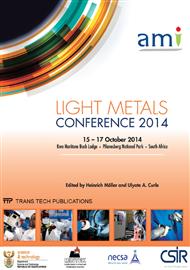p.143
p.152
p.160
p.169
p.177
p.187
p.195
p.204
p.210
Microstructure and Compression Creep Strength of the Newly Developed Magnesium Alloy DieMag422
Abstract:
Magnesium alloys have been finding increasingly more types of application in the automotive and aerospace industries for over twenty years. Despite the fact conventional magnesium alloys have limited high-temperature strength and creep resistance, especially when they contain aluminium as an alloying element. Aluminium is necessary to improve the castability when high-pressure die casting is the favoured process. Applications with higher operating temperatures require additional alloy elements, which form precipitates with the aluminium during solidification and therefore prevent the formation of Mg17Al12, which is responsible for the low creep resistance of magnesium alloys that contain aluminium. The precipitates formed may also strengthen grain boundaries and so improve the creep strength. Barium and calcium were investigated as elements in a magnesium alloy containing aluminium (DieMag422: 4 wt.-% Al, 2 wt.-% Ba, 2 wt.-% Ca). The compression creep strength was compared at 240°C for stresses between 60 and 120 MPa with two commercial creep-resistant magnesium alloys, AE42 and MRI230D. The stress exponents were calculated from the stress dependence of the minimum creep rate. The concept of a threshold stress was applied and true stress exponents nt close to 5 were found. The new alloy DieMag422 exhibits improved creep strength compared to both commercial alloys and also has proven it is die castable.
Info:
Periodical:
Pages:
177-183
Citation:
Online since:
October 2014
Authors:
Keywords:
Price:
Сopyright:
© 2014 Trans Tech Publications Ltd. All Rights Reserved
Share:
Citation:


